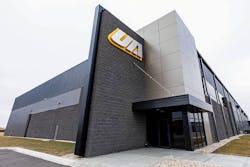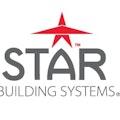Applying conventional construction to custom metal buildings
Creating innovative design alternatives through mixed construction methods
The old adage, “opposites attract,” might as well be describing the increasingly common practice of mixing the technology of custom metal building systems with conventional construction. By taking the indisputable sustainability, time savings, and structural benefits of a custom-engineered metal frame, and then adding in design elements you can only achieve with traditional products such as brick or glass, many builders and designers are finding great solutions for a host of building requirements.
Among the benefits and considerations for combining custom metal buildings with conventional construction applications are:
- These custom-engineered metal buildings take a few months to get but they can be fast-tracked as necessary. If you can design and order to meet a specific production date to receive all those elements, you can continue to design and develop the project while the metal framework is in manufacturing.
- The only real limitation is if the footprint of the building significantly changes. But, if you know such factors as the square footage, how the roof’s going to drain, how the building will be oriented, height, etc., you can add masonry features, glass features, and open up walls; you can do all kinds of things to give the building architectural interest to satisfy a design vision and community requirements.
- Star Building Systems is doing more to insulate these types of buildings for exceptional performance, and is therefore meeting all standards of new energy code requirements.
- The metal framework substantiates the bones of the building and the conventional products and methods are used in conjunction in order to enhance the design. Most of these items are for aesthetic purposes and don’t impact the skeletal system.
- Builders and designers need to integrate these systems with the manufacturer, respectful of seismic loading, wind loading, and environmental impact.
- Ask questions up front to avoid headaches later, such as whether a specific span is acceptable or what if you left out an entire wall of panels and conventionally constructed a wall in its place? Will this create problems? Headaches equate to delays in timelines, and delays equate to money. A builder or designer should work together with the metal panel manufacturer to ensure everything will work together seamlessly.
- It’s extremely cost effective and efficient in that you can get these buildings assigned, that is, get your production slot in advance so you know when you’re going to receive your steel while you’re still going through the entire design and approval process with the municipalities and all of the other participants of the project, etc.
Timothy Kritter, PE, AIA, founder of Madison, Wisconsin-based TJK Design Build, has used this combined methodology on many of his firm’s design-build projects, essentially taking the bare bones of the metal framework, “tricking them out,” and creating a design that works within the parameters of a given project.
Kritter, who uses Star Building Systems for much of TJK’s custom metal framing needs, explains the advantages he’s seen: “Star Building Systems eliminates a lot of the complexity and allows us to make enhancements with other components to add interest. Every owner has a vision and wants to leave a mark, and each planning commission has their own requirements. We can work with Star to provide the bones of the structure and then we can apply the applications and the materials we want to make the building meet the aesthetic requirements after the fact. What’s great about starting with the custom-engineered metal building framework is that we can have everything in the works and rolling from a timing standpoint, especially since this type of building shell goes up much faster than conventional construction. Logistically, it helps us plan when that framework will be on site.”
A recent example of applying conventional construction to a custom metal building is the United Alloy headquarters in Janesville, Wisconsin. For this TJK project, the single largest conventional impact on the building was the crane systems that was installed inside the building. Kritter notes, “While Star has the engineering capacity to provide crane systems, this particular customer wanted to provide their own cranes. So, we had to integrate the crane loading for all the heavy product parts that needed to be moved around inside the building. We had to take all that weight and get it resolved safely within the design of the Star structural system. That wasn’t aesthetics, that was pure engineering.”
From a design standpoint, this building sits on a very prominent interchange from the interstate as you come into the small city of Janesville. The city was adamant that the building be architecturally relevant. TJK took the two facades that were closest to the entrances to the city and integrated glass, masonry, and steps to create reliefs in the wall systems to promote shadowing; the team highlighted a tall glass entry, which, according to Kritter, is no more complicated than just eliminating part of the metal building and inserting a glass framework in its place, basically accenting the corner of the building with conventional elements.
Kritter describes how they integrated the processes, noting, “We maximized the bay spacing to have the most flexible floor plan possible. It’s a campus of buildings and we connected two of the buildings with a 2-story skyway, which has a conveyor system that carries parts from one building to another building. That was all conventionally constructed but was tied in with the experts at Star in terms of how the buildings connected. The use of two different tone panel colors was used to give the building some diversity, breaking up these massive expanses of metal, which created shadowlines and diminished the height of the structure. While you want as much height as you can have on the inside, you don’t want this big, imposing structure looming over the landscape.”
He adds, “The Star metal framing that we use is great and is very cost effective. The Star engineers are a great team to work with. They’ll be as flexible as we need them to be. My advice to other builders looking to integrate these building types is to try to work within the engineered metal system but understand it’s still malleable. There are so many innovative ways to reshape it to make it what you need and want it to be.”
One final piece of advice from Kritter, as an experienced architect, engineer and designer: “Don’t pretend the building isn’t a metal frame. Don’t brick it from bottom to top and say you’ve got an all-brick building. Rather, design details that integrate into what the metal panel manufacturer is providing. For us, we celebrate that with architectural features that aren’t necessarily tacked on to the building. Do some things that look like they’re integrated into the facade of the building using the materials that Star provides, and come up with color palettes, come up with ways to take what they provide and integrate some nice design elements. There’s no question that it’s a metal building but it’s a very attractive and uniquely designed custom-engineered building, and I think that speaks well to Star’s product.”

